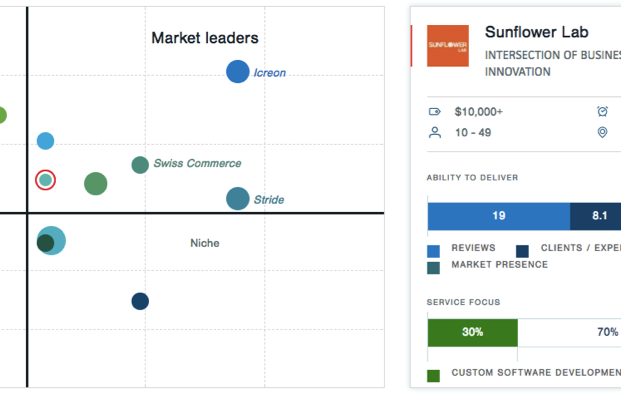When to use custom software development services – Benefit from optimized business automation and agile work processes to enhance your brand quality.
Businesses today compete fiercely to create a special niche for their product and services to retain their competitive edge. It has become increasingly important for them to get the most out of their in-house processes to stimulate ROI generation. The reliability of in-house processes, for most organizations, depends largely upon the particular technology used and how well their IT processes are maintained.
Organizations depend upon software automation to streamline their internal processes. The better the software, the more streamlined the processes become, which leads to improved productivity levels. Therefore, it is imperative to use a computerized system that not only fulfills the business needs, but which is also affordable and easy to scale as and when businesses grow.
There’re two main choices while automating business processes:
1. Opt for ready made (bespoke) or packaged or “off-the-shelf” software
2. Design customized software specially tailored to fulfill your exact needs
While there are many benefits of choosing ready made software, the cons outweigh the benefits of using them. Ready made software applications, also referred to as commercial applications, include pre-defined functionality. They are specially designed to satisfy the needs of most business-types, so the feature functionality they offer is generic, and fails to target specific organizational requirements – which is the main cause of concern. Each business is unique and follows processes unique to its specific needs. Therefore, ready made packages tend to fulfill most organizational needs but fail when processes or the business scope changes. In such cases, one has to upgrade existing software or buy a new product offering a new set of features and functionality. This can lead to budgetary concerns as businesses might be forced to invest in new products.
So how can you determine whether your organization needs customized software or ready made applications? A few pointers may help you identify the nature of your software related needs.
1. Design and development
The main points to consider are price and the delivery time. While ready made software can be availed at affordable prices and one can start using them right away, the problem is they’re more “product” oriented rather than being “solutions” oriented. An off-the-shelf application is predominantly designed to address common business needs and directly target the end users – it is not required to focus upon any specific process or business-centric requirement. This makes commercial applications rigid and useless for organizations having very specific work processes and distinct end user requirements.
Custom software development services provide a “company focused” approach that concentrates more upon what the business actually needs and how end users are going to use a particular process. Moreover, users, stakeholders and project owners are engaged early, and more often, with the design process. Their suggestions provide useful insights in determining the scope and applicability of proposed software systems.
Another advantage of opting for customized software development is you can design a hybrid architecture consisting of ready made as well as tailor-made applications. This is possible when data is shared across the entire platform since data originating from one process often functions as an input for another.
2. Implementation
The point here is how effortlessly the organization can setup and use the new software system. A tailor-made software is generally installed by a custom software development company team along with end users working in the organization. Since developers interact and engage with process users during the development process, the latter are more conversant with project specifics, and therefore find it easy to adopt the new system.
Packaged software is usually installed by the company personnel or by third-party contractors, neither of whom are actively involved with developing the software. Training guides and instruction manuals try to make the implementation part easy, but the drawback is each process user has to be educated in using the new software system which means several hours or even days of wasted productivity time that has to be borne by the organization.
3. Processes
The point to think about is how efficiently the software can support the automation process. The ability of software to support a company’s operating processes is the most important element in deciding between custom made software and off-the-shelf applications.
A custom built, branded user interface provides customers and process users a highly personalized, tailor-made user experience. This can also help in creating an efficient channel for facilitating direct sales and creating new engagements.
This is not possible with ready made software as the process flows and automation options are already predefined and don’t have much scope for personalization. Custom software development services make personalization possible.
4. Costs
A major point to consider is the cost factor involved in developing or purchasing the software. While packaged software might seem affordable, there could be hidden costs involved such as buying a third-party gadget or a plugin, or other software to make it compatible with existing system processes.
Moreover, large or complex systems might require the organization to order special trainers or consultants so the process users can learn how to use and implement the new system. There is a price tag attached to training sessions and organizations have to bear the added cost.
Another point to consider is the scalability aspects of the new software. Businesses evolve with time, and with evolution, new requirements and scope creep in. What is the cost of upgrading the packaged software? What is even more important is the fact whether a new upgrade will be made available in the future or not, and if so, will it fulfill the scope and business requirements existing than?
The fourth point is planning the operational budget and controlling the overheads. With ready made software you either buy the software or you don’t – there are no other options. That is not the case with customized software development. You have the freedom of deciding which of the processes you feel are more important and need to be automated first. You can control the budget spending by phasing out the development process over several months. You invest only in those processes first which bring about tangible and fruitful results. As the business earns from the particular process through the automation process, it can generate extra capital which can be utilized for automating other processes over time.
5. Time to implement
The point to consider is how long will the implementation take? Will it be days, weeks or months? Packaged software can be installed and set up quickly – One can start using them right away, which is a major advantage of buying ready made software. However, think about the nature of the system – Is it a simple, small sized application which can be easily installed and introduced in the work flow? How about systems like Oracle, JD Edwards, or SAP? They are ready made software but consume a lot of time before you can start using them as you have to customize them as per your specific needs and fine tune them to suit your working.
Customized software will take time to develop, test and implement. Also, there’s no guarantee it will be one hundred per cent bug free even if it’s tested thoroughly – exceptions tend to occur.
6. Support and upgrade
The point to ponder over is how frequently and when you’ll need support facilities and upgrade options. Packaged software are designed and marketed to function as revenue generating tools, so keeping in tune with the marketing philosophy, they’ll be releasing periodical upgrades to keep on earning from existing users. However, since they focus upon processes generic to the entire business vertical rather than specific business processes, there’s no guarantee a future upgrade will wholly satisfy your business-centric requirements existing at that time.
With custom software development you own the software as well as its code and intellectual rights so you have the freedom to plan, design and time all future updates as per your requirements.
7. Flexibility
The point is how flexible it is to maintain the software over time. The feature functionality found in packaged software relies upon market trends, and what the manufacturer thinks in terms of how many businesses and users will opt for what features in the future, and how flexible they need to be for mass consumption. The flexibility aspect is therefore dependent upon what conditions are likely to exist in the near or distant future. There’s no guarantee the packaged software you’re using today will be usable or made redundant in a couple of years’ time.
Custom software development is process-centric and focuses upon satisfying process owners. Because the software is designed internally, the resulting system offers a level of flexibility generally not found in packaged software. Process changes can be identified and implemented as and when needed and change requests don’t have to traverse through several levels of organizational bureaucracy. Custom software is specially tailored, possesses agility, and is more cost effective in certain instances as compared to packaged software. It can be an excellent automation choice for all small to medium-sized companies.
Conclusion
It can be difficult to choose between packaged software or customized software. However, if you’ve specialized work processes or you’re keen on optimizing your process flow and get the most out of your IT infrastructure, custom software development would be the ideal choice for your organization.
You might also like
Stay ahead in tech with Sunflower Lab’s curated blogs, sorted by technology type. From AI to Digital Products, explore cutting-edge developments in our insightful, categorized collection. Dive in and stay informed about the ever-evolving digital landscape with Sunflower Lab.






